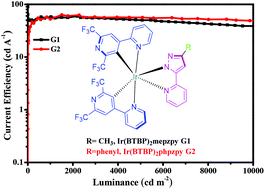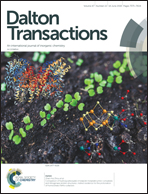Highly efficient bluish green organic light-emitting diodes of iridium(iii) complexes with low efficiency roll-off†
Abstract
Two novel iridium(III) complexes Ir(BTBP)2mepzpy and Ir(BTBP)2phpzpy were successfully synthesized, in which 2′,6′-bis(trifluoromethyl)-2,4′-bipyridine (BTBP) was used as the main ligand, and 2-(3-methyl-1H-pyrazol-5-yl)pyridine (mepzpy) and 2-(3-2-(3-phenyl-1H-pyrazol-5-yl))pyridine (phpzpy) were introduced as the ancillary ligands, respectively. Both Ir(III) complexes displayed bluish green emission peaks at 486 and 487 nm with high quantum efficiencies of 0.73 and 0.69, respectively. The organic light-emitting diodes (OLEDs) with the structure of ITO/HATCN (hexaazatriphenylenehexacarbonitrile, 5 nm)/TAPC (bis[4-(N,N-ditolylamino)-phenyl]cyclohexane, 40 nm)/Ir(BTBP)2mepzpy or Ir(BTBP)2phpzpy (10 wt%): 2,6-DCzPPy (2,6-bis(3-(9H-carbazol-9-yl)phenyl)pyridine, 10 nm)/TmPyPB (1,3,5-tri[(3-pyridyl)-phen-3-yl]benzene, 30 nm)/LiF (1 nm)/Al (100 nm) exhibited high efficiencies with low efficiency roll-off. Especially, the device based on the Ir(BTBP)2mepzpy complex achieved a maximum current efficiency of 58.17 cd A−1 and a maximum external quantum efficiency of 25.33% with Commission Internationale de 1′Eclairage coordinates of (0.19, 0.43). These results indicate that novel cyclometalated Ir(III) complexes for high efficiency OLEDs with low efficiency roll-off were obtained by our rational design.



 Please wait while we load your content...
Please wait while we load your content...